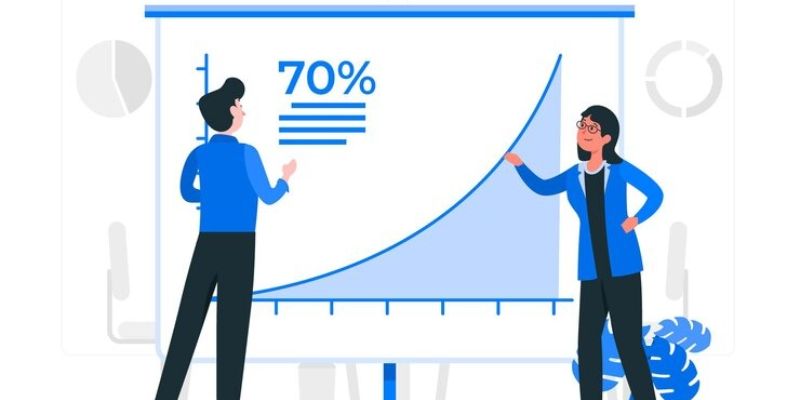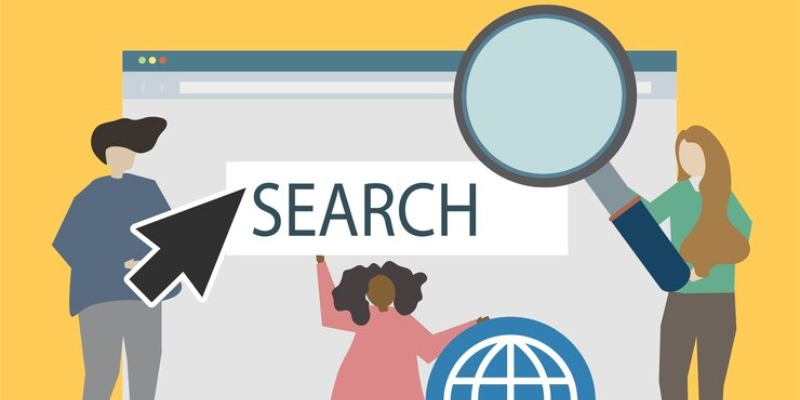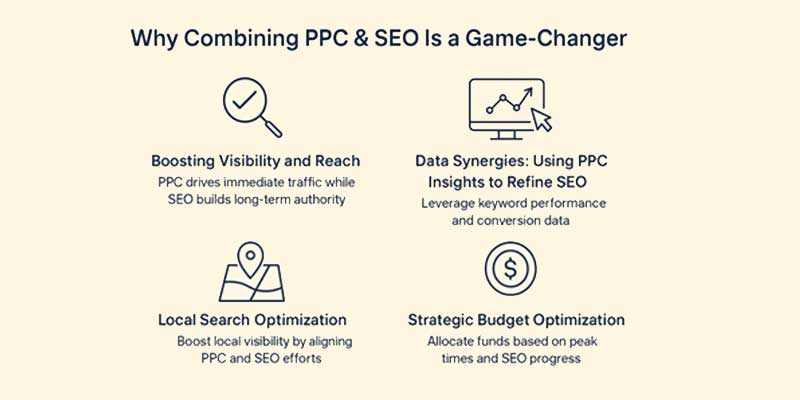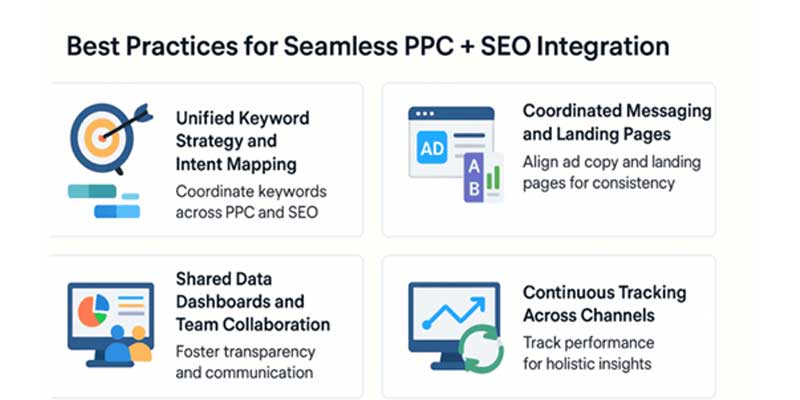

One of the most potent strategies combining SEO with PPC has primarily been aimed at maximizing the effects of digital marketing efforts. These two strategies differ mainly because while SEO refers to organic search rank and long-term growth, PPC is all about attaining instant targeted online visibility through paid advertising. With the power of each, you could make a harmonious ensemble for marketing that converts into your online presence and drives more focused traffic to your website.
Search Engine Optimization (SEO) is the practice of improving a website’s visibility on search engines like Google, Bing, and Yahoo by ranking organically for relevant keywords. Unlike paid ads, SEO focuses on earning traffic naturally by enhancing factors such as on-page content quality, technical optimization, backlinks, and user experience.
For businesses, SEO acts as a long-term digital asset. A well-optimized page continues to attract visitors months or even years after it’s published—making it a cost-effective approach. With Google’s AI-powered search and evolving algorithms, modern SEO also demands strong E-E-A-T signals (Experience, Expertise, Authoritativeness, and Trustworthiness).
In short, SEO ensures your brand consistently appears in front of the right audience, builds credibility, and delivers compounding returns over time.
Pay-Per-Click (PPC) advertising is a digital marketing model where businesses pay a fee each time someone clicks on their ad. These ads appear at the top of search results, on social platforms, or across partner websites, giving brands instant visibility.
PPC campaigns are powered by platforms like Google Ads, Meta Ads, and LinkedIn Ads, allowing advertisers to target audiences by keywords, demographics, interests, and behavior. Unlike SEO, PPC offers immediate traffic but requires ongoing budget allocation.
The biggest advantage of PPC is control. You decide who sees your ad, how much you spend, and when your campaign runs. It’s also measurable in real time—marketers can track clicks, conversions, and cost per lead to fine-tune performance.
While both SEO and PPC aim to drive traffic and conversions, they operate differently:
When combined, PPC and SEO form a balanced digital strategy. PPC fills the gap by driving immediate traffic while SEO builds sustainable authority. Together, they maximize visibility, reinforce brand trust, and provide data insights to refine overall marketing efforts.
Getting organic reach is a long-term SEO play. You will see great results after months, but once you start ranking well, you will enjoy constant traffic without any repeating payments (except for content creation, link building, etc. PPC gives instant online visibility. You can target specific and relevant keywords, and you can target the target demographics as well. The ads will appear at the top of the Search Engine Results Pages (SERPS).
A high chance of seeing something several times increases brand awareness and trust of any site organically ranking for a term, such as Google Ads.
SEO is centered around ranking on high-value, high-intent terms via organic content, page optimization, and ultimately, backlink acquisition. PPC gives you the option to bid on extremely competitive and relevant keywords. For example, ones you won't rank for immediately with SEO.
One of the good things about PPC campaigns is that you might quickly realize which keywords give the best ROI. All this information can be fed back to your SEO strategy, so you know which are the high-converting keywords to aim for when it comes to organic ranking. Alternatively, you could use SEO to target long-tail keywords that would be cheaper in your PPC campaigns.

Local SEO ensures your business ranks well on relevant local searches and increases your visibility in your locality. With PPC, you can target local keywords or set specific geographic parameters to run ads in targeted areas.
Local SEO will get your business to rank naturally for local search terms, while PPC allows you to hyper-target locations and audiences. So a small business may be ranking for its local terms organically, but at the same time, it can run paid campaigns to capture quicker leads from close customers.
One of the biggest challenges in digital marketing is deciding how much to allocate between SEO and PPC. Both require investment, but their timelines and returns are very different—making a smart budget strategy essential.
PPC for Peak Demand
Pay-Per-Click campaigns are highly effective during high-intensity periods such as product launches, seasonal sales, or festive promotions. Since ads appear instantly at the top of search results, PPC ensures maximum visibility when competition is fierce. For example, an e-commerce brand running Diwali or Black Friday promotions can use PPC to capture buyer intent in real time.
SEO for Sustainable Growth
Search Engine Optimization, on the other hand, compounds over time. Once your content and web pages rank organically, they can continue generating leads at little additional cost. This makes SEO a reliable strategy during off-peak times when immediate conversions are less critical but consistent brand visibility is still necessary.
Balancing the Two
A balanced approach means using PPC as a short-term accelerator and SEO as a long-term foundation. Studies show that businesses integrating both are able to reduce overall customer acquisition costs by leveraging SEO’s “free” traffic while using PPC to dominate high-value keywords during peak demand windows strategically.

PPC and SEO often chase the same audience but in different ways. A unified keyword strategy prevents duplication and maximizes efficiency.
SEO keywords should focus on long-tail and informational queries that build authority and answer customer questions.
PPC keywords should prioritize high-intent, transactional queries where conversions are more immediate.
By mapping keywords against the buyer’s journey (awareness, consideration, decision), businesses ensure they’re visible across every stage. PPC data on click-through rates and conversion trends can also refine SEO targeting, while organic search insights reveal long-term content gaps for PPC campaigns to exploit.
Consistency across paid and organic channels builds trust. If a PPC ad promises “Free Consultation in 24 Hours,” the organic landing page should reinforce the same message.
Align headlines and CTAs between PPC ads and SEO pages.
Keep branding uniform to avoid user confusion.
Optimize landing pages for both speed and relevance, ensuring they serve organic visitors and convert paid traffic effectively.
This coordinated approach prevents disconnects that may cause drop-offs and improves Quality Score in PPC, which lowers cost-per-click.
PPC is a fast, controlled testing ground. Marketers can run A/B tests on ad copy, offers, or landing page layouts and apply the winning variations to SEO pages. Conversely, content that ranks well organically can inspire new PPC creatives.
Test headline variations on ads, then bring the best performers into SEO title tags.
Compare organic vs. paid CTRs for the same keyword to identify messaging gaps.
Experiment with conversion funnels, using PPC to validate before rolling out changes sitewide.
This cross-testing loop creates a feedback system that steadily improves both channels.
Too often, PPC and SEO teams work in silos. Shared dashboards bridge the gap. By consolidating data in tools like Google Data Studio, Looker, or HubSpot, both teams can track:
Regular collaboration ensures PPC isn’t bidding aggressively on keywords already dominated by SEO, while SEO can prioritize keywords that are too costly in PPC. The outcome is a cost-efficient, unified growth strategy.
Integration is not a one-time setup—it’s an ongoing process. Continuous tracking across PPC and SEO ensures campaigns adapt to shifts in algorithms, competition, and user behavior.
This holistic measurement approach provides clarity on true ROI and keeps both strategies aligned with business goals.

In July 2025, Google rolled out AI Mode—a search experience powered by its Gemini 2.5 Pro model. Unlike traditional search, AI Mode doesn’t just list links; it synthesizes multiple sources into a direct, conversational answer.
Key features include:
For digital marketers, this means competition isn’t just for the “10 blue links” anymore—it’s for answer visibility inside AI-generated summaries.
AI Mode represents both opportunity and disruption. Because Google’s AI synthesizes responses from multiple sources, fewer users may click through to individual websites. This is where Answer Engine Optimization (AEO) becomes crucial.
Instead of writing only for human readers, content creators must now write for both users and machines—ensuring answers are easy for AI to parse and credible enough to be cited.
To increase the chances of appearing inside AI Mode responses, follow these best practices:
By layering these elements, your content becomes both AI-friendly and user-friendly—ensuring visibility in zero-click AI answers and organic rankings.
While PPC doesn’t directly influence organic ranking, it can strengthen brand authority signals that AI Mode uses when selecting content.
In short, PPC provides the real-time performance validation that reinforces SEO content credibility, making it more appealing for Google’s AI to highlight in its synthesized answers.
At their core, PPC and SEO complement each other because they share the same goal—helping brands capture attention at the exact moment users search. SEO builds organic credibility, while PPC buys instant visibility. Together, they create a “digital marketing blend” that covers both short-term wins and long-term growth.
Think of it like this: SEO is the slow-burn engine that builds authority over time, while PPC is the turbocharger that delivers immediate acceleration. When combined, they keep your brand visible, competitive, and trusted across the entire search ecosystem.
Successful brands don’t treat PPC and SEO as separate silos—they integrate workflows to maximize results. For example:
By aligning teams and data, companies create a cycle where paid and organic feed each other, improving efficiency and reach.
Budget efficiency is often the deciding factor in digital marketing. Here’s how a combined PPC + SEO strategy ensures smarter spend:
The July 2025 Google core update reinforced one reality: search is no longer just about “10 blue links.” With AI Mode now front-and-center, results increasingly feature AI Overviews, conversational answers, and multimodal insights.
Key shifts from this update:
For brands, the implication is clear: optimize content for AI-driven discovery, not just search results. Structured, authoritative, and conversational content is more likely to be surfaced inside these AI responses.
As AI Overviews expand, the risk of zero-click searches grows—where users get answers directly from Google’s interface without visiting websites. This shift demands a focus on Answer Engine Optimization (AEO).
Steps to prepare:
The goal is to ensure that even if Google uses your content in summaries, your brand gets cited, earning visibility and authority—even without a click.
In the AI search era, relying solely on organic traffic metrics paints an incomplete picture. Success now requires tracking new forms of visibility and engagement.
Key metrics to consider:
By shifting focus from just clicks to brand visibility, influence, and assisted outcomes, businesses can truly measure the value of their SEO + PPC strategy in the AI-first search landscape.
By combining SEO and PPC ads, you can get optimum results. Bud is a digital marketing agency in Bangalore that can help you run successful PPC ads and perform SEO with the help of our digital marketing experts, who can get maximum results. Apart from being a well-known PPC agency in Bangalore, Bud also provides SEO services in Bangalore.